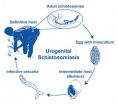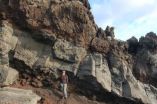(Press-News.org) National Museum of Natural History scientist Bert Van Bocxlaer and an international team of researchers revealed that anthropogenic changes in Africa's Lake Malaŵi are a driving force behind the increase of urogenital schistosomiasis, a debilitating tropical disease caused by parasitic flatworms. Scientists estimate that 250 million people are affected by schistosomiasis worldwide, and 600 million more are at risk of contracting it. In some villages along the shorelines of Lake Malaŵi, 73 percent of the people and up to 94 percent of the schoolchildren are infected with urogenital schistosomiasis, one of several forms of the disease. Van Bocxlaer's research suggests that this spike in infection is directly linked to an increase in human populations and agricultural activities near Lake Malaŵi, and may include a change in the dietary preferences of mollusk-eating fishes. Details from this study and recommendations to reduce the prevalence of urogenital schistosomiasis are published in the May 2014 issue of Trends in Parasitology.
Human population densities in Malaŵi have more than doubled during the past 30 years, resulting in increased land use, overfishing and ecological changes that create a favorable environment for Bulinus nyassanus, a small freshwater snail that acts as an intermediate host of the disease-causing parasite. Infected snails release larval flatworms that can penetrate human skin upon contact with water. Humans are the definitive host and, upon infection, excrete eggs that hatch in water and infect snails such as B. nyassanus.
"Scientists have long known that environmental changes can affect public health, but our research reveals that human impact on the environment plays a larger role in the spread of schistosomiasis than previously thought," said Van Bocxlaer. "Decreasing the transmission of this infectious disease will require an integrated control program for schistosomiasis, including community-based health education with efforts toward more sustainable resource use."
Van Bocxlaer and his team discovered that human activities surrounding Lake Malaŵi
have led to drastic biotic and abiotic changes in the lake's ecosystem. Observed changes include an increase in sedimentation and nutrient influx due to agricultural initiatives and soil erosion. B. nyassanus thrives in the shallow, nutrient-rich sandy sediments along shorelines that humans frequent, and it faces few natural predators because populations of fish that feed on this snail have greatly declined due to overfishing. Scientists also suspect that the fish have a decreased affinity for eating B. nyassanus, favoring instead a recently introduced non-native form of the snail Melanoides tuberculata.
The research team examined sediment archives and compared historical and modern populations of B. nyassanus to determine ecological changes in Lake Malaŵi over time. The scientists relied on historical data, such as those preserved in museum collections, to determine that changes in snail populations in southern Malaŵi that, in conjunction with the impacts of human activities in this region, have contributed to an increase of schistosomiasis during the past several decades.
Symptoms of schistosomiasis generally originate in the urogenital organs and the intestines and can lead to life-threatening complications. Estimates from the World Health Organization suggest that more than 200,000 deaths per year are due to schistosomiasis in sub-Saharan Africa alone; approximately one-third of the total deaths caused by malaria worldwide.
INFORMATION: END
Scientist uncovers links connecting environmental changes with spike in infectious disease
Human activities near Lake Malawi lead to rise in parasitic infections
2014-05-21
ELSE PRESS RELEASES FROM THIS DATE:
Scaly gem discovered in South American cloudforests
2014-05-21
Field and laboratory work by Omar Torres-Carvajal from Museo de Zoología QCAZ, Pontificia Universidad Católica del Ecuador, and his former undergraduate student Simón Lobos has resulted in the discovery of a gem-looking new species of shade lizard from the cloudforests in northwestern Ecuador. This region is part of the 274,597 km2 Tumbes-Chocó-Magdalena hotspot that lies west of the Andes. The study was published in the open access journal ZooKeys.
Shade lizards (genus Alopoglossus) are widely distributed across tropical South America. They differ from most other lizards ...
Shattering past of the 'island of glass'
2014-05-21
A tiny Mediterranean island visited by the likes of Madonna, Sting, Julia Roberts and Sharon Stone is now the focus of a ground-breaking study by University of Leicester geologists.
Pantelleria, a little-known island between Sicily and Tunisia, is a volcano with a remarkable past: 45 thousand years ago, the entire island was covered in a searing-hot layer of green glass.
Volcanologists Drs Mike Branney, Rebecca Williams and colleagues at the University of Leicester Department of Geology have been uncovering previously unknown facts about the island's physical history.
And ...
The interruption of biological rhythms during chemotherapy worsen its side effects
2014-05-21
Patients receiving chemical treatment for cancer often suffer fatigue and body weight loss, two of the most worrying effects of this therapy linked to the alteration of their circadian rhythms.
The circadian system, better known as our biological clock, is responsible for coordinating all the processes that take place in our organism.
If it does not function correctly, what is known as a circadian disruption or chronodisruption, has for years been linked to an increased incidence of cancer, obesity, diabetes, depression, cognitive problems or cardiovascular diseases.
"Also, ...
New tide gauge uses GPS signals to measure sea level change
2014-05-21
A new way of measuring sea level using satellite navigation system signals, for instance GPS, has been implemented by scientists at Chalmers University of Technology in Sweden. Sea level and its variation can easily be monitored using existing coastal GPS stations, the scientists have shown.
Measuring sea level is an increasingly important part of climate research, and a rising mean sea level is one of the most tangible consequences of climate change. Researchers at Chalmers University of Technology have studied new ways of measuring sea level that could become important ...
Dam removal improves shad spawning grounds, may boost survival rate
2014-05-21
Research from North Carolina State University finds that dam removal improves spawning grounds for American shad and seems likely to improve survival rates for adult fish, juveniles and eggs – but for different reasons.
The researchers focused on a small tributary in North Carolina called the Little River, where three dams were removed in the late 1990s and early 2000s. American shad (Alosa sapidissima) spend the bulk of their adult lives in saltwater, but return to freshwater rivers like this one to spawn. While in these freshwater environments, the adult shad do not ...
Breakthrough: Nasal spray may soon replace the pill
2014-05-21
Every time we have an infection or a headache and take a pill, we get a lot more drugs than our body actually needs. The reason is that only a fraction of the drugs in a pill reaches the right places in the body; the rest never reaches its destination and may cause unwelcome side effects before they are flushed out of the body again. This kind of major overdosing is especially true when doctors treat brain diseases, because the brain does not easily accept entering drugs.
"People with brain diseases are often given huge amounts of unnecessary drugs. During a long life, ...
Seeing is a matter of experience
2014-05-21
The headlights – two eyes, the radiator cowling – a smiling mouth: This is how our brain sometimes creates a face out of a car front. The same happens with other objects: in house facades, trees or stones – a "human face" can often be detected as well. Prof. Dr. Gyula Kovács from Friedrich Schiller University Jena (Germany) knows the reason why. "Faces are of tremendous importance for human beings," the neuroscientist explains. That's why in the course of the evolution our visual perception has specialized in the recognition of faces in particular. "This sometimes even ...
Cyberbullying affects rich and poor alike
2014-05-21
EAST LANSING, Mich. --- Cyberbullying isn't just a problem in middle class and affluent areas. Teenagers in poor, high-crime neighborhoods also experience online bullying, finds new research led by a Michigan State University criminologist.
The study suggests the "digital divide" – the gap between people with access to online technologies and those without – may be nonexistent, at least when it comes to cyberbullying, said Thomas J. Holt, MSU associate professor of criminal justice.
"We found neighborhood conditions that are indicative of poverty and crime are a significant ...
NASA sees developing tropical cyclone in Bay of Bengal
2014-05-21
VIDEO:
In this TRMM 3-D simulated flyby of System 92B from May 19, tall storms were shown reaching heights of over 14km (about 8.7 miles).
Click here for more information.
A tropical low pressure area known as System 92B has been organizing in the Northern Indian Ocean's Bay of Bengal and NASA's TRMM satellite has shown strong thunderstorms and heavy rainfall in the developing storm.
The Tropical Rainfall Measuring Mission or TRMM satellite passed over System 92B on May 19 and ...
Shared custody is becoming the norm
2014-05-21
It's no longer a certainty that American mothers will get custody over their children during a divorce. In fact, if Wisconsin Court Records of the past 20 years are anything to go by, joint custody is becoming the norm. So says Maria Cancian and colleagues from the University of Wisconsin–Madison in the US, whose findings are published in Springer's journal Demography.
For most of the twentieth century, in both divorce and nonmarital cases, most children ended up living with their mothers after their parents' divorce. This conformed to gender norms that views mothers ...
LAST 30 PRESS RELEASES:
American College of Cardiology comments on new dietary guidelines for Americans
American Society of Gene & Cell Therapy and Orphan Therapeutics Accelerator partner to advance and commercialize promising rare disease treatments
One in 14 patients having day case surgery have new or worse chronic pain 3 months after their operation
New study highlights link between eviction rates and gun violence
Heatwaves heat up soil but not toxin levels in rice, study finds
Digital modeling reveals where construction carbon emissions really come from
Turning farm waste into water filters
New study shows how the spleen helps the immune system accept a transplant
New Mayo Clinic study advances personalized prostate cancer education with an EHR-integrated AI agent
Researchers identify novel therapeutic target to improve recovery after nerve injury
Microbes in breast milk help populate infant gut microbiomes
Reprogramming immunity to rewrite the story of Type 1 diabetes
New tool narrows the search for ideal material structures
Artificial saliva containing sugarcane protein helps protect the teeth of patients with head and neck cancer
Understanding the role of linear ubiquitination in T-tubule biogenesis
Researchers identify urban atmosphere as primary reservoir of microplastics
World’s oldest arrow poison – 60,000-year-old traces reveal early advanced hunting techniques
Bristol scientists discover early sponges were soft
New study uncovers how rice viruses manipulate plant defenses to protect insect vectors
NSF–DOE Vera C. Rubin Observatory spots record-breaking asteroid in pre-survey observations
Ribosomal engineering creates “super-probiotic” bacteria
This self-powered eye tracker harnesses energy from blinking and is as comfortable as everyday glasses
Adverse prenatal exposures linked to higher rates of mental health issues, brain changes in adolescents
Restoring mitochondria shows promise for treating chronic nerve pain
Nature study identifies a molecular switch that controls transitions between single-celled and multicellular forms
USU chemists' CRISPR discovery could lead to single diagnostic test for COVID, flu, RSV
Early hominins from Morocco reveal an African lineage near the root of Homo sapiens
Small chimps, big risks: What chimps show us about our own behavior
We finally know how the most common types of planets are created
Thirty-year risk of cardiovascular disease among healthy women according to clinical thresholds of lipoprotein(a)
[Press-News.org] Scientist uncovers links connecting environmental changes with spike in infectious diseaseHuman activities near Lake Malawi lead to rise in parasitic infections








